![]()
|
Grimwades
Ltd |
|
Location and period of operation:
|
Grimwades
Ltd |
Hanley |
1900 |
1964 |
|
Earthenware manufacturer - originally at the Winton Pottery, just on the Hanley side of the border of the pottery towns of Hanley and Stoke, Stoke-on-Trent, England. The works were named after Winton Wood.
In 1900 the original Grimwade Bros became Grimwades Ltd - they expanded production significantly and within 10 years had purchased a number of existing companies to help with the growth. Winton Pottery
Works was their original and largest factory and this name gave rise to their well-known "Winton Ware." By the 1920s-30s, they were producing art deco patterns as well, with more stylised geometrics and bright glazes. Grimwades Royal Winton became well known for chintz ware — full-pattern, all-over floral transfer designs - notable Chintz patterns were "Summertime," "Hazel," and "Sweet Pea".
Later use of the 'Winton' name: In 1964 Grimwades Ltd was acquired by the Howard Pottery Group and the business traded as Royal Winton. In 1995 the ownership of Royal Winton changed and the new owner reverted back to the original name of Grimwades Ltd although they continued to trade as 'Royal Winton'.
Summary of the history of Grimwades Ltd:
NOTE: In 1995 the ownership of Royal Winton changed and the new owner reverted back to the original name of Grimwades Ltd although they continued to trade as 'Royal Winton'. |
Previously: Grimwade Bros
Subsequently:
Royal Winton
jump to:
| Leonard Grimwade biography | Grimwade adverts | examples of Grimwade ware |
| Grimwade chintz |
| identification marks | Winton Pottery Works |
|
GRIMWADE, Leonard Lumsden (c. 1863-1931), pottery manufacturer, Stoke upon Trent. Leonard Grimwade was born in Ipswich about 1863, the son of Richard Grimwade. He began his business life with his uncle as a dry salter in Ipswich. He came to the Potteries as a modeller but quickly moved to manufacturing. He was joined by his brother, Sydney, by 1886, and worked the Winton Pottery. The style became Grimwade's Ltd. in March 1900. Leonard Grimwade went for a time to Australia but returned to the Potteries.
A serious fire at the Winton factory in 1916 led to Leonard Grimwade proposing that Stoke on Trent should have at least three motor fire engines.
He modified his free-trade views to some extent during the First World War, by which time his five factories employed 1,000 people. In December 1917 he printed a message from the prime minister asking for economy in consumption of food on reduced sized butter dishes, milk jugs and plates, which sold at one shilling each. He married twice and had two sons and two daughters. His first wife, Marion, was elcted to the Stoke Board of Guardians in 1897. He was killed in a road accident on 26 January 1931 and was buried in Hartshill cemetery. Sources: Jewitts, Pottery Gazette 2 March 1931; VCH ii., People of the Potteries. |
|
Pottery Gazette - January 1906
|
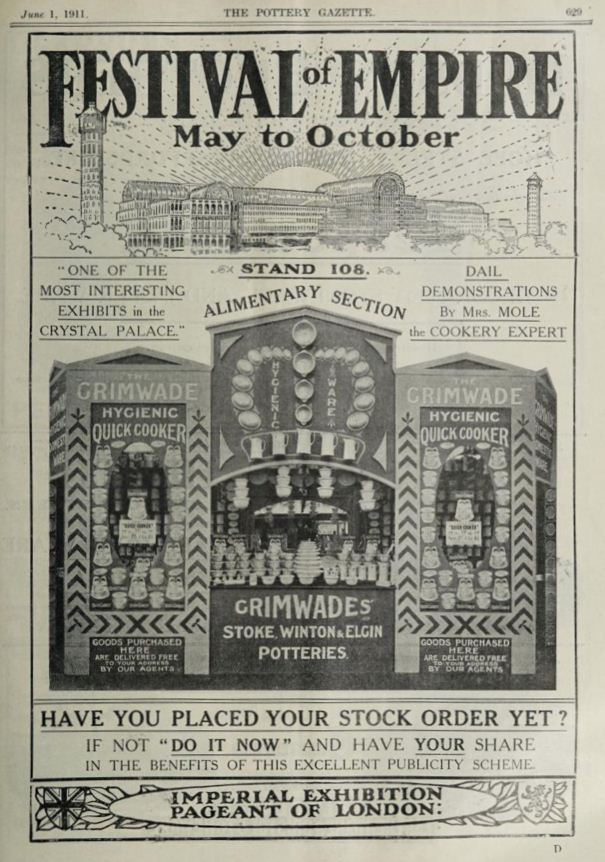 Grimwades advert for their stand at the Festival of Empire held at The Crystal Palace, London in 1911 |

Cover of a 1906 Grimwades Ltd
export catalogue and price list
at this time they operated from four works: the Winton Pottery, Stoke Pottery, Elgin Pottery and Upper Hanley Pottery
Examples of ware produced by
Grimwades:
|
Grimwades were prolific manufacturers producing 100s and 100s of patterns. Winton Ware became one of their flagship lines. Their range grew to include fine tableware, commemorative pieces, and novelty items — including miniature ware and promotional ceramics. By the 1920s-30s, they were producing art deco patterns as well, with more stylised geometrics and bright glazes. Grimwades Royal Winton became well known for chintz ware — full-pattern, all-over floral transfer designs.
|

Grimwades Limited
Stoke-on-Trent
NANCY is the pattern name - the
registration
number shows that the pattern was registered in 1902
fragment found on the mud banks
of the River Thames in 2021
courtesy: Adam Walczak

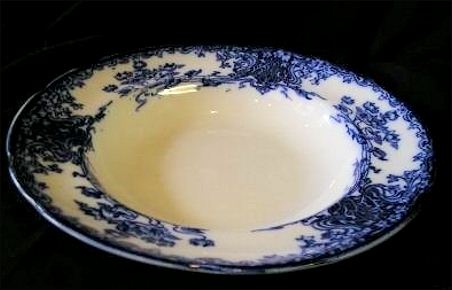
examples of a tureen and a soup
bowl in the Nancy pattern
 moulded serving dish with hand painted pattern and gilt accents |
 Grimwades Stoke-on-Trent this style of mark with the shell like vase in the centre is not well documented it is likely to be c.1906 - early 1910s |
photos courtesy: Helen Tombolato (Australia)
 jug by Grimwades in their Adam Style pattern introduced c.1904 The name of the pattern is 'Adam' after the famous neo-classical architect and designer Robert Adam |

detail of the rams head on the handle
|
 Grimwade's Winton GB Stoke-on-Trent England impressed mark ADAM
|

|
|
Atlas China
Stoke-on-Trent
Grimwade
England
this mark revived by Grimwades
c. 1930-36
 Child's warming plate with nursery rhyme Grimwades produced a range of nursery and children's ware |
 Grimwades Stoke-on-Trent England mark introduced in the 1930s |
photos courtesy: Kate Jones
 cup with Welsh village scene |
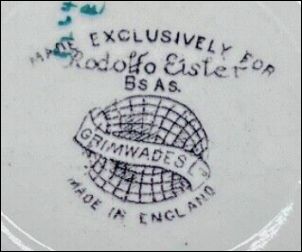 Made exclusively for Rodolfo Eister Bs As Grimwades Ltd Made in England |
|
Rodolfo Eisler was an importer of quality ceramics, silver and homewares that were primarily made in England. His shop was based in Buenos Aires, Argentina. He
imported ware from a number of North Staffordshire potteries including The
Pearl Pottery and Newport
Pottery (Clarice Cliff ware). |
 part of a 12 setting dinner service
|

marks used on
various items
|
photos courtesy: John & Julie Fritz
Grimwades Chintz Ware
|
The term "chintz" itself originally referred to printed cotton fabrics with floral patterns that came from India in the 17th century, and the ceramic industry borrowed that name for the dense, all over floral patterns that they began to produce. In 1928 Grimwades began producing chintz patterns with "Margauerite" being the first. This was an immediate success and a number of chintz patterns were introduced in the 1930s. These tightly grouped, highly detailed and vibrant all over floral patterns were to become a milestone in the company's reputation for versatility and beauty. With the exception of an moratorium on decorated ware in the Second World War period, production of chintz continued until the early 1960s, when it was discontinued due to the high production costs associated with this style of decoration. In 1995 the new owners (Grimwades trading as Royal Winton) recognised the value of the chintz pattern and reintroduced it in the form of collector's pieces. The year 1995 was incorporated into the backstamp of the new chintz to avoid confusion with previous production. |

Marguerite
|
Introduced around 1928 Marguerite was the first of the Chintz patterns produced by Grimwades. The Marguerite pattern has a white background with a floral design of various upright and daisy like flowers. It is a more 'open' design then subsequent chintz patterns which were usually very densely patterned. |
|
|
|
|
notable Chintz patterns were "Summertime," "Hazel," and "Sweet
Pea"
Trade names used:
UPPER HANLEY POTTERY
STOKE POTTERY
ROYAL WINTON
RUBIAN ART
GRIMWADES
|
Marks used on ware for identification: In 1900 the style changed
from Brimwade Bros. to
Grimwades (plural), marks with Grimwade Grimwades used a wide variety of marks, some for a short period of time. Some of their ware with the month/year of manufacture - so 8/22 would be August 1922. The name "Royal Winton Ware" was in use from as early as 1897 it was around 1929 that 'Royal Winton' was introduced as a recognisable trade name by Grimwades Ltd. |

this table of marks appears in
the 1917 edition
of the Pottery Gazette Reference Book
Stoke Pottery marks
|
the
registration number 218780 shows that the pattern was registered to |
c.1900+ this mark was used by Grimwades for a short period after they took over the Stoke Pottery of James Plant in 1900 |
The S. P. will refer to Stoke Pottery c.1900+ photo courtesy: Sam Anderson-Mangai |
Upper Hanley Pottery marks
 UHP Grimwades England |
 UHP Grimwades Staffordshire England |
 Upper Hanley Pottery Grimwades Staffordshire England |
c.1906-1911
early 1906
the Upper Hanley Pottery company was
wound up and Grimwades
took on the business at the Brownfield
Works until around 1911

G Ltd
Trade Mark
Stoke-on-Trent
c. 1900-1906
Guelda is probably the pattern name
the style of the 'G' is similar to that used by the predecessor Grimwade Bros.

Grimwades Trade Mark Stoke-on-Trent Carro will be the pattern name |

Grimwades Stoke-on-Trent there is often a single letter or number to the left of the central vase - it is not certain what this refers to |
this style of
mark with the shell like vase in the centre is not well
documented it is likely to be c.1906 - early 1910s
 G B Winton Stoke-on-Trent England |
 Grimwades Winton Stoke-on-Trent England |
c.1906+

Grimwades
Potteries
England
c.1911+
Cube teapot marks
 The Cube Made under license by Grimwades Ltd Stoke-on-Trent England |
 Rubian Art Pottery |
plain
white ware marked with the |
|
A number of North Staffordshire potters produced this ware. Grimwades produced The Cube in many different patterns including Chintz, art deco, Willow, plain white. They also produced coffee pots, milk jugs and sugar bowls to complement the set. |
post 1930
marks

Grimwades Stoke-on-Trent England |
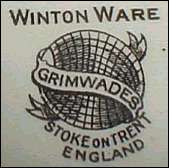
Winton Ware Grimwades Stoke-on-Trent England |
c.1930+

Grimwades England Vitro Hotel Ware |

Grimwades Royal Winton Ivory England |

Grimwades England |

Royal Winton Ivory |
 Rubian Art Pottery England |
c.1930+
around 1930 a series of simple marks was introduced -
these could easily be added to the ware using a simple rubber stamp
Atlas China
 |
 |
|
|
Atlas China this style of mark was previously
used by Atlas China Co |
c. 1934-39 |
|
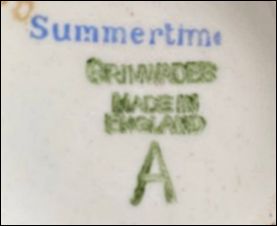 Grimwades Made in England A |
 Royal Winton Made in England A |
Summertime is the pattern name
marks with a letter 'A'
likely indicate ware
that was made under
the Wartime
Concentration Scheme of the Second World War
- this patterned ware was probably for export -
 Royal Winton Grimwades Ltd Made in England c. 1934-50 |

marks with a letter 'A' indicate ware that was made under the Wartime Concentration Scheme of the Second World War |
c. 1934-50 |
 Royal Winton Grimwades Ltd Made in England c. 1951+ |
 Royal Winton Made in England c. 1951+ |
Winton Pottery Works
- see more information on Winton Pottery -

Winton Pottery
"Messrs. Grimwade Brothers established their Winton Pottery (Stoke) in
about 1886.
A wide range of useful and decorative earthenware was produced."
From: Jewitts 'Ceramic Art of Great
Britain 1800-1900.
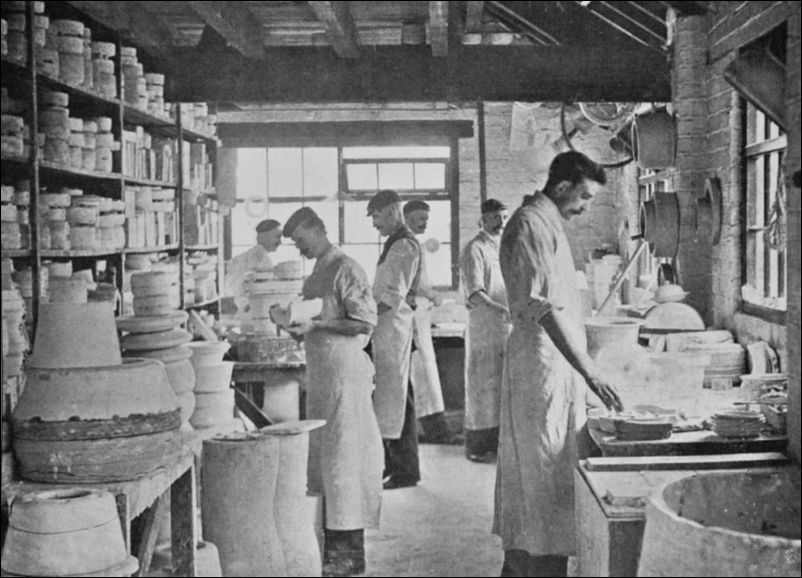
Mould Makers' Shop, Winton Pottery

plate making at the Stoke pottery

Aerographing for decorating by compressed air

Gilding and enamelling the Royal Winton Ware
| Grimwades and Davenport patterns |
Questions, comments, contributions? email: Steve Birks